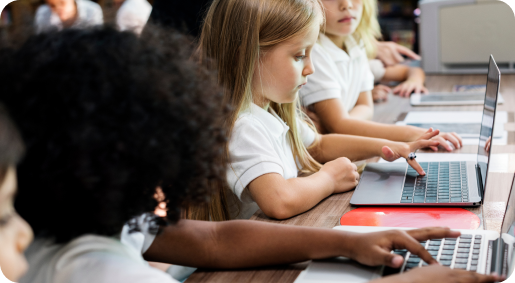Digital learning platforms
Digital learning platforms have become the cornerstone of today’s teaching practices, providing educators with the tools to create interactive lessons, share multimedia resources, and engage students in ways that weren’t possible a few years ago.
Platforms like Google Classroom, Canvas, and Moodle allow students and teachers to communicate seamlessly while being accessible and flexible at the same time. These platforms empower teachers to cater to diverse learning styles and individual student’s needs, creating a more inclusive and personalised approach to learning.
Personalised learning
One of the biggest impacts technology has had on teaching has been the introduction of personalised learning. Through advanced data analytics, teachers can track individual student progress and tailor learning experiences to suit each learner’s unique needs. Students who may have struggled in the past because they don’t learn in the same way as their classmates are now given more opportunities as teachers are able to understand their requirements better.
Teachers can even use adaptive learning systems with AI to adjust the difficulty level of teaching material in real-time, creating personalised learning experiences for different students based on their strengths and weaknesses.
Collaborative tools
Modern technology has completely changed the way we collaborate inside of the classroom. Virtual classrooms, discussion forums, and collaborative documents – such as Google Docs – have become integral to the educational process.
These tools encourage teamwork and communication among students, preparing them for the “real world”, where they will be expected to collaborate with team members, colleagues, and associates. Through online collaboration, students can work on projects, share ideas, and provide feedback, giving them a sense of community within the classroom.
Interactive learning resources
We’ve taken quite a leap from traditional teaching methods with the integration of interactive learning resources. Educational games, simulations, and virtual reality experiences engage students and offer them a hands-on approach to learning complicated concepts.
These resources not only make learning fun, but they also help learners understand what they’re learning and retain information better. Of course, it’s important to strike a balance between screen time and traditional teaching methods to ensure we’re providing the best education possible.
Finding the balance
While technology can clearly have a positive impact on learners’ educational experience, there is also a need to regulate the use of some tools.
Advancements in AI and the popularity of platforms like ChatGPT are good examples of this. It’s easier than ever to gather and share information, but there is also the risk that students lose the ability (and willingness) to research and learn for themselves.
As we head into a more resource-rich future, educators have an important role to play in teaching students the value of patience and in enjoying the learning process. The last thing we want is a generation of young people over-reliant on easy-to-find information and an inability to research and think for themselves.
Fostering an environment where exploring, challenging, and asking questions is encouraged is more important than ever.
The smart use of technology defines the modern era of teaching and the way students learn today. For many years, schools fought technology, not wanting it to distract learners from their education. Now, we know that it can be a useful tool to enhance the educational experience.
We’re always looking to connect tech-savvy teachers with schools that celebrate innovation. If you’re looking for your next teaching role, get in touch with Now Education.





